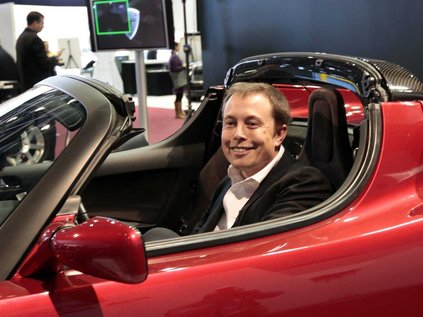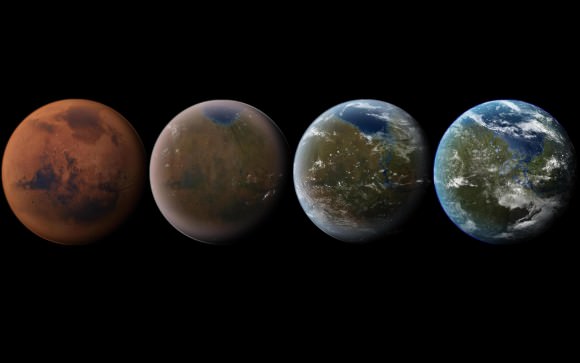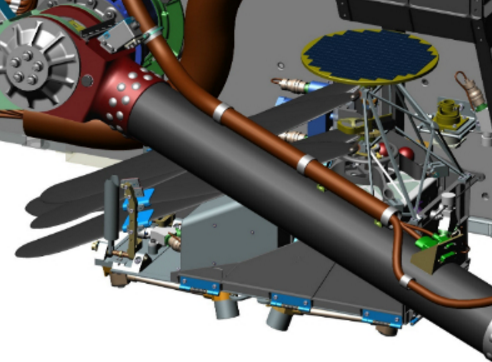|
Mars scientists should heed the Falcon Heavy demo as a wakeup call that the days of their exclusive access to Mars is coming to an end.
I think most of us reacted with some combination of awe, amusement, and chagrin that SpaceX’s inaugural Falcon Heavy payload would be Elon’s midnight cherry red Tesla Roadster playing David Bowie’s “Space Oddity” on a Mars Transfer Orbit. It is going to be a very special launch, whatever happens. But some space enthusiasts and Mars lovers that reacted differently to the announcement. Opportunities for sending stuff to Mars are pretty rare, and the exceptional mass transfer capability of the Falcon Heavy would be a wonderful opportunity to do things in Mars exploration that have not been done before. Instead of sending a car, we could be sending something that will help us better understand the planet Mars, and teach us new things about the solar system. There are also potential hazards from this launch. Sending a vehicle that has been used and driven around all over the earth also means that it is going to be covered in small, biological organisms all over, underneath the seats and the nooks and crannies. Not to mention a lot of Elon’s dead skin and hair cells, providing food for all sorts of critters. If the upper stage has a malfunction and manages to accidentally hit Mars, some of that biological residue or even viable lifeforms / spores would certainly survive.
The reaction among more scientifically oriented space fans and the planetary science community seemed to be one of disappointment, or even a little anger. Maybe I am over-interpreting a sarcastic twitter account, but I know there are many who sincerely feel this way.
Ignoring the actual risks associated with putting a payload on this mission and getting usable data out of it, I wrote this post specifically to discuss this attitude that I see from many in the planetary science community. They have been doing space science for so long and are so focused that they seem to think the penultimate goal of spaceflight exclusively to do science in space. However, they are not the only valid stakeholders who wish to do things in space and on other planets! Many people, currently building rockets and space capsules, are ready to settle, colonize, or otherwise develop space resources and planets. There is a clash in ideologies between these two groups that has been dormant since the end of the apollo program, but will surface once again. And as has happened before, those arguing for the conservation of objects in space will lose more than they win.
In the 1950’s, it was believed that the moon might have a tenuous atmosphere. It was determined by a group of scientists that until this atmosphere could be properly studied, no nation should fire a rocket thruster anywhere in the vicinity of the moon. But as we all know, this was promptly ignored as soon as the technology matured to the point where it could happen. There were some scientists who had concerns about contaminating the moon with chemical or biological material, but those concerns were brushed aside because of the importance of the space race. Since then, Human spaceflight and planetary science have been at peace because the planets have been ignored. There has never been a national imperative to put people on the moon or dig through the icecap of Europa. The rest of the solar system has been the exclusive domain of science because it has been ignored by everyone else. The solar system has been the exclusive domain of scientific NASA payloads for generations, and some might have convinced themselves it will stay that way forever. But that exclusive use will come to an end in the next decade. A cherry-red Tesla rising in the Martian sky at 10,000 mph is certainly a way to break the quiet. The Planetary Science community needs to come to terms with the coming horde. The tide of commercial and non-scientific payloads coming to Mars will become more and more of a threat to science year after year. When concerns are raised about damaging the pristine environment, they will not have the political capital to preserve Mars in all they ways they want to, and once the technology and willpower is there, their concerns will be brushed aside.
To Planetary Scientists:
The Solar System is not your private laboratory. You cannot control and regulate what other people will do once they leave earth, and you certainly can’t stop anyone from living on Mars. The time of exclusive use for science is coming to an end, and the clock is ticking to perform astrobiological science on Mars before the biosphere is changed forever.
0 Comments
I was very excited when I read that ULA had decided to bring elements of the ACES upper stage forward and begin work on Centaur V. This will be a 5.4 meter diameter stage, likely use the BE-3U engine, and not feature the poorly acronymed but technically wonderful Integrated Vehicle Fluids (IVF). I was a never a fan of the awkward, iterative development plan that was first shown with the Vulcan announcement. It focused early development on the first stage to remove the dependency on the RD-180 engines, but kept the upper stage at a 4 meter diameter, keeping Centaur unchanged until it was replaced by ACES. Bringing forward a few critical items from ACES to Centaur V is a brilliant move by Tory Bruno. The most important thing it does is increase the lift capacity of the first generation Vulcan, so it can carry all of the national security payloads. This means that as soon as it is qualified and in operation, ULA can immediately retire both the Atlas V and Delta IV families of rockets. Having to support 2 completely different, enormous rockets places a huge strain on ULA's ability to produce rockets in high quantities, and now that SpaceX has ended their monopoly on national security payloads, they can't afford that anymore. This is a good move. But I wanted to offer a different development path that could potentially get Vulcan flying a little quicker for a lower cost, and still satisfy their need to replace the Delta-IV heavy. Instead of investing in new tooling and re-qualifying the main propellant tanks of centaur to a new diameter, they could instead choose to keep the 3.05 meter diameter and stretch the tanks to length to meet the payload requirements needed to keep the national security payloads flying. Vulcan is expected to have the capability to place about 40,000 kg in LEO in its final version, but to replace the Delta-IV heavy, you only have to be able to lift 28,790 kg. With this assumption in mind, I tried to figure out what a stretch Centaur V would look like. Obviously, the engineers at ULA must have considered this, weighed it against their options, and rejected the plan for any number of reasons. They have far more insight into their engineering bandwidth, manufacturing capability, actual performance and mass data, and future business climate than I do. A lot of them are outright better engineers than me too. That said, its fun to engage in a little speculation.
To make these estimations I started with some assumptions backed up with some hasty research about Centaur and the BE-3 engine. I plugged some numbers in to a python script and generated some lengths for what a stretched Centaur would look like given a target Delta-V and mass. I put the code up on github, so play around with it and see what you can come up with, or tell me what errors I made.
https://github.com/Lars-0/StretchedCentaur/ NASA just released this beautiful rendering of the 2020 Rover and I am ecstatic to see all of the details and new features that this rover has. It shows a Martian Helicopter and critical details about the sampling and caching system. Let's take a detailed look at what has stayed the same and what has changed compared to the Curiosity rover. I won't be covering the instruments because I am not familiar with them and because there is really excellent information on NASA's website. Unfortunately, there are not any renderings of the Curiosity rover as nice as this one, so we will need to compare it to actual photographs. A lot is obviously the same: the Chassis, the mast, RTG (Radioisotope Thermoelectric Generator) and the mobility system (excepting wheels) are basically identical. The arm also looks the same excepting the payloads on the end. Many of the parts that will be part of the 2020 rover were actually flight spares from Curiosity. When this rover launches, many of the parts will be over 10 years old.  I think everyone knows about the issues Curiosity has had with it's wheels. It has already been announced that they will be thicker than the previous ones, but the difference is neglible in the rendering. There is a subtle change in the grousers compared to the curiosity design, being a little straighter. I also see no evidence they will leave morse-code messages in the sand, either. The rest of the wheel assembly appears to remain unchanged. The drill really stood out to me, because I've seen it, and worked with it before! Although it has not been announced yet, this rendering shows a design based on drills made by Honeybee Robotics. I think this means the must be the prime contractor for both the drill and caching system. You can see the heritage to their ROPEC and RANCOR drill. It is a coring drill capable of doing ~5cm long cores, and has a brilliant way of doing core break off and capture. The the drill bit, plus the sample inside, can then be transferred the cache. I am thrilled that Honeybee is making the drill for the 2020 rover, and am proud of all of the hard work my former colleagues put into it. Most of the drill is obscured, so it is not possible to see the motor for advancing the drill, percussion motor, bit change motor, and core breakoff. It is also possible there is only one motor, but I suspect that to get maximum performance they will use a separate motor for each function. The caching system is new to the rover, and represents the ultimate goal of this mission's purpose: to collect and store samples so they can be brought back to earth by future missions to Mars. Mars sample return has been a holy grail of planetary science for decades. Once a sample has been cored, the arm will move to align the drill to to the sample cache using the alignment features. The drill will screw the core into a sleeve, and in doing so the sample will be sealed. Then the cache will turn, presenting the next coring bit. The fresh coring bit is unscrewed from its holder and used to drill another sample. When the mission has been completed and all of the core drills are full, the arm will be able to remove the cache from the rover body, and set it on the ground somewhere that is nice and accessible. Later, another rover will pick it up and take it to an ascent vehicle, which will launch from the surface of Mars, and eventually bring it back to earth. All this will likely happen another decade after the 2020 rover lands. There is also a helicopter on the rover! This is thrilling, and is a very bold step for the JPL team. I had seen some press on early R&D for a martian helicopter which would be used for occasionally flying up to altitude and getting photos to help plan drives. This is one of those things that seems crazy at first, and will be very impressive if they can go from research project to landing on Mars in 5 years. There is an extra piece of structure that has been added on the rear over the RTG. I have been trying to figure out what it could be, and why the 2020 rover may need it when Curiosity didn't, but I don't know. Everything else in the area looks identical. However, It's a crazy structure, it looks really fun to design and make.
I hope NASA makes a habit of releasing detailed CAD renderings, it was a lot of fun to pick through this. Or, why things take so long. It would be forgivable to believe that as a product’s design nears completion the engineer’s job is pretty much done. If they did it well, there is a complete documentation package that production can use to build 1 or 10 or 100 of the item that was designed. But it is surprising how much engineering effort is required between design completion and hardware delivery. Production engineering is an often overlooked, but critical bridge between the drawings and the hardware. I have found production engineering to be of vital importance even in the early stages, before the first serial number has been completed.
I was born and raised in Fairbanks, Alaska. Auroral displays are frequent in the winter, and I spent many evenings in my youth observing the glowing plasma “clouds” above me. I would stay out as the aurora faded to look at the stars in that dark sky. I don’t remember when I learned that the stars we see are other suns, but I haven’t been able to see them as anything else since. They are more than points of light in the sky, but real places. These days, whenever the Seattle clouds open up and I glimpse planets or stars in the night sky, I feel myself pulled towards them. They ask us to come visit.
|
Lars OsborneBS Mechanical Eng Categories
All
|











 RSS Feed
RSS Feed
